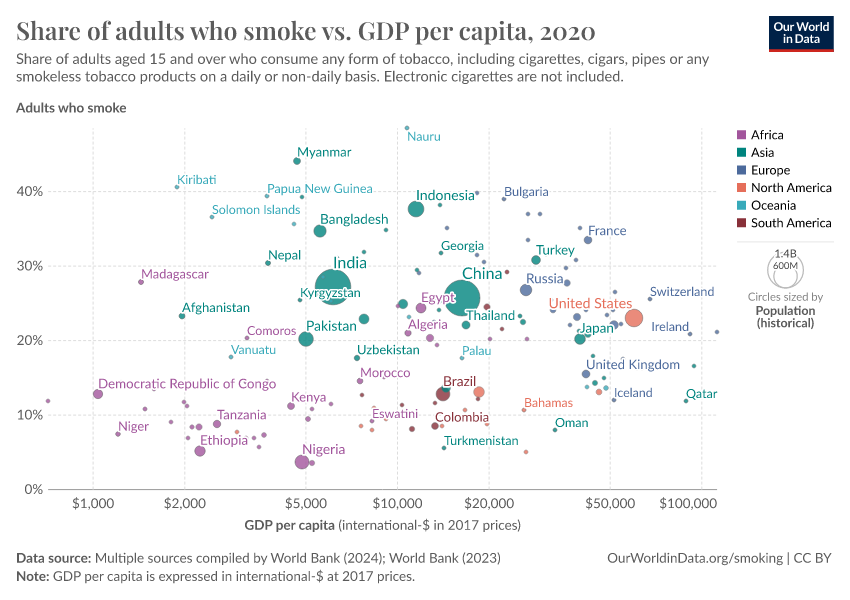Share of adults who smoke or use tobacco

What you should know about this indicator
- Smoking is a risk factor for chronic complications, such as cancers or cardiovascular disease, and can lead to premature death.
- This estimate is based on national surveys conducted within the last 10 years. The WHO uses the survey data as the basis for a statistical regression model to estimate the prevalence of smoking in the adult population for each year and country. Where no or only incomplete survey data is available, the model uses data from similar countries to estimate the prevalence of smoking. You can find more information about the methodology in the WHO publication
Related research and writing
What you should know about this indicator
- Smoking is a risk factor for chronic complications, such as cancers or cardiovascular disease, and can lead to premature death.
- This estimate is based on national surveys conducted within the last 10 years. The WHO uses the survey data as the basis for a statistical regression model to estimate the prevalence of smoking in the adult population for each year and country. Where no or only incomplete survey data is available, the model uses data from similar countries to estimate the prevalence of smoking. You can find more information about the methodology in the WHO publication
Sources and processing
This data is based on the following sources
How we process data at Our World in Data
All data and visualizations on Our World in Data rely on data sourced from one or several original data providers. Preparing this original data involves several processing steps. Depending on the data, this can include standardizing country names and world region definitions, converting units, calculating derived indicators such as per capita measures, as well as adding or adapting metadata such as the name or the description given to an indicator.
At the link below you can find a detailed description of the structure of our data pipeline, including links to all the code used to prepare data across Our World in Data.
Notes on our processing step for this indicator
- We calculate regional aggregates as population weighted averages of the country-level estimates. The populations is based on the UN World Population Prospects 2024, the regions we use are defined here.
Reuse this work
- All data produced by third-party providers and made available by Our World in Data are subject to the license terms from the original providers. Our work would not be possible without the data providers we rely on, so we ask you to always cite them appropriately (see below). This is crucial to allow data providers to continue doing their work, enhancing, maintaining and updating valuable data.
- All data, visualizations, and code produced by Our World in Data are completely open access under the Creative Commons BY license. You have the permission to use, distribute, and reproduce these in any medium, provided the source and authors are credited.
Citations
How to cite this page
To cite this page overall, including any descriptions, FAQs or explanations of the data authored by Our World in Data, please use the following citation:
“Data Page: Share of adults who smoke or use tobacco”, part of the following publication: Hannah Ritchie and Max Roser (2023) - “Smoking”. Data adapted from World Health Organization. Retrieved from https://archive.ourworldindata.org/20250925-232706/grapher/share-of-adults-who-smoke.html [online resource] (archived on September 25, 2025).How to cite this data
In-line citationIf you have limited space (e.g. in data visualizations), you can use this abbreviated in-line citation:
World Health Organization - Global Health Observatory (2024) – processed by Our World in DataFull citation
World Health Organization - Global Health Observatory (2024) – processed by Our World in Data. “Share of adults who smoke or use tobacco” [dataset]. World Health Organization, “Global Health Observatory” [original data]. Retrieved December 25, 2025 from https://archive.ourworldindata.org/20250925-232706/grapher/share-of-adults-who-smoke.html (archived on September 25, 2025).
